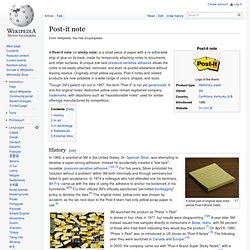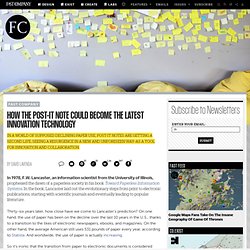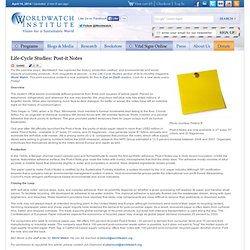

FAQs. General Products FAQs Digital Notes FAQs Questions about Memoboards I only have one tab on my memoboard — can I hide the tab?

Questions about Note Subscriptions Questions about Bookmark Notes Answers to your questions Question 1.Are all Post-it® paper products recyclable? Yes. 3M has conducted recycling trials on Post-it® Notes at recycled paper mills. . ^ Back To Top Question 2.Are Post-it® Notes made from recycled paper? There are many colors and sizes of Post-it® Notes available with paper containing at least 30% postconsumer recycled content. Question 3.Why doesn't 3M make all Post-it® Notes and Easel Pads with 100% recycled paper? There is a limited supply of recycled fiber from which new paper can be made. Question 4.Why should I buy recycled content products like Post-it® Recycled Notes? Recycling is an important strategy for diverting waste from overcrowded landfills. How self-adhesive note is made - making, history, product, industry, machine, History, Raw Materials, The Manufacturing Process of self-adhesive note, The Future.
Background Self-adhesive notes, also called "sticky notes," are partially adhesive, detachable note papers that have revolutionized memo making.

Throughout the country, it seems almost every surface in an office is amenable to the little yellow notes: they're stuck to desks, computers, files, folders, and rolodexes. Home is not off bounds either; the notes appear frequently on cabinet doors, telephones, and refrigerators. The tremendous appeal of sticky notes is in part because they are so easy and convenient to use. They can be placed exactly where you want them without any fasteners like tacks, paper clips, or staples.
As pervasive as sticky notes are, they are a newcomer in the office supply market. History Sticky notes were a long time in the making, involving many people and obstacles. By defying scientific rationale, Silver discovered a totally unique phenomenon—a new polymer that was only partly sticky, not "aggressively" adhesive. Hymnal. Raw Materials The Manufacturing Process. Post-it note. A Post-it note (or sticky note) is a small piece of paper with a re-adherable strip of glue on its back, made for temporarily attaching notes to documents and other surfaces.

A unique low-tack pressure-sensitive adhesive allows the notes to be easily attached, removed, and even re-posted elsewhere without leaving residue. Originally small yellow squares, Post-it notes and related products are now available in a wide range of colors, shapes, and sizes. Though 3M's patent ran out in 1997, the term "Post-it" is not yet genericized.
It and the original notes' distinctive yellow color remain registered company trademarks, with depictions such as "repositionable notes" used for similar offerings manufactured by competitors. History[edit] Life-cycle assessment. Life-cycle assessment (LCA, also known as life-cycle analysis, ecobalance, and cradle-to-grave analysis)[1] is a technique to assess environmental impacts associated with all the stages of a product's life from-cradle-to-grave (i.e., from raw material extraction through materials processing, manufacture, distribution, use, repair and maintenance, and disposal or recycling).

LCAs can help avoid a narrow outlook on environmental concerns by: Compiling an inventory of relevant energy and material inputs and environmental releases;Evaluating the potential impacts associated with identified inputs and releases;Interpreting the results to help make a more informed decision.[2] Life Cycle Assessment Overview Goals and purpose[edit] The goal of LCA is to compare the full range of environmental effects assignable to products and services in order to improve processes, support policy and provide a sound basis for informed decisions.[3] There are two main types of LCA.
Four main phases[edit] PostitNotePersuasion. How The Post-it Note Could Become The Latest Innovation Technology. In 1978, F.W.

Lancaster, an information scientist from the University of Illinois, prophesied the dawn of a paperless society in his book Toward Paperless Information Systems. In the book, Lancaster laid out the evolutionary steps from print to electronic publications, starting with scientific journals and eventually leading to popular literature. Thirty-six years later, how close have we come to Lancaster’s prediction? On one hand, the use of paper has been on the decline over the last 10 years in the U.S., thanks to a transition to the likes of electronic newspapers, ebooks, and magazines.
On the other hand, the average American still uses 531 pounds of paper every year, according to Statista. So it’s ironic that the transition from paper to electronic documents is considered innovative and futuristic, while the newest tool in the innovation shed might just turn out to be a 2,000 year old invention: paper. From Document Routing to Innovation Catalyst. Life-Cycle Studies: Post-it Notes. Photo courtesy Peteris B Post-it Notes are now available in 27 sizes, 57 colors, and 20 fragrances.

For the past five years, Worldwatch has explored the history, production method, and environmental and social impacts of everyday products - from chopsticks to pencils - in the Life-Cycle Studies section of its bi-monthly magazine, World Watch. This print-exclusive content is now available for free to Eye on Earth readers. Look for a new study every Friday! Overview The modern office seems incomplete without guidance from three-inch squares of yellow paper. They began in 1980, when a St. One year after 3M officially launched the Post-it Note, the packs of sticky paper raked in more than US$2 million in sales. Production In the 1940s, a Belgian chemist mixed carbolic acid and formaldehyde to create the first synthetic adhesive.
The paper used to make Post-it Notes is certified by the Sustainable Forestry Initiative, a system founded by the U.S. paper industry. Closing the Loop.